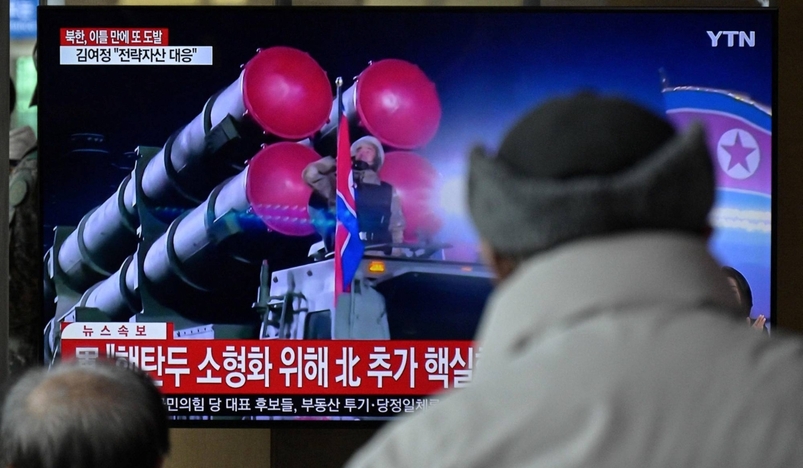
North Korea launches two ballistic missiles
North Korea launched two ballistic missiles into the waters off the east coast of the Korean Peninsula, officials said – the latest missile launch in recent days by the country.
Japan’s Defense Ministry said officials were still analyzing the data but estimated both missiles were fired at around 7:00 a.m. local time on Monday and fell into the Sea of Japan “to the east of the Korean Peninsula, outside Japan’s exclusive economic zone,” its statement said.
North Korea acknowledged the incident, calling it a “super-large multiple rocket launcher exercise, which is a means of tactical nuclear attack.” The country said the exercise was a response to the combined air force forces of the United States and South Korea.
Both countries conducted joint air training on Sunday, according to South Korea’s Ministry of National Defense just after North Korea warned Friday of “unprecedented strong responses” if military exercises were conducted.
US Air Force B-1B strategic bombers were deployed on the Korean Peninsula with escort assistance from F-35As, F-15Ks, and F-16s from the South Korean and U.S. Air Forces, South Korea’s Ministry of National Defense said.
“Through timely and immediate deployment of the US extended deterrence force on the Korean Peninsula, the two demonstrated the SK-US combined defense capability and posture by the alliance’s overwhelming force and improved combined operational capability,” the Ministry’s statement said.
Washington and Seoul are also expected to hold nuclear tabletop drills this week at the Pentagon, the South Korean Defense Ministry said Friday. The allies plan to hold additional military drills next month in the Korean Peninsula.
The state-run media Korean Central News Agency (KCNA)’s report on the launch said the Korean People’s Army (KPA) mobilized two 600 mm radial guns and fired multiple projectiles. South Korea considers multi-rocket launchers larger than 600 mm as ballistic missiles.
Japan’s Defense Ministry recorded that the first missile was launched at around 6:59am local time and flew about 400 km (248 miles) at a maximum altitude of about 100 km (62 miles). The second missile was fired at around 7:10 a.m. local time at a maximum altitude of around 50 km (31 miles).
The Japanese Coast Guard said in an earlier statement on their official website that North Korea launched three suspected ballistic missiles, however, South Korea’s Joint Chiefs of Staff said only two short-range ballistic missiles were detected.
Japan’s coast guard issued an alert to vessels Monday morning local time and advised to “keep an eye out for further information.” The agency also told vessels to stay away from falling objects and report any sightings to the coast guard.
Kim Yo Jong, the sister of North Korean leader Kim Jong Un and one of the country’s top officials, released a statement Monday around the time of the suspected missile launch.
Kim said in the statement, which was posted on KCNA, that North Korea has “satisfactory technology and capabilities” for missile reentry and now all that remains is “to focus on increasing the number of forces.”
“Instead of doubting or worrying about other people’s technologies, it would be better to think more deeply about countermeasures to defend yourself,” Kim said.
She also said that if North Korea deemed the presence of US forces in the region as a threat, they would take “corresponding measures,” and added, “the frequency of using the Pacific Ocean as our shooting range depends on the nature of the US military’s actions.”
A day before the incident, North Korea acknowledged it conducted a test Saturday of an intercontinental ballistic missile (ICBM), its third known test of the long-range weapon in less than a year.
The state-run Korean Central News Agency said a Hwasong-15 ICBM was fired in a “surprise ICBM launching drill” under the written orders of leader Kim Jong Un.
The missile flew 989 kilometers (614 miles) for almost 67 minutes to an altitude of 5,768.5 kilometers (3,584 miles), according to the KCNA report.
It said the test was proof of Pyongyang’s ability to launch a “fatal nuclear counterattack on the hostile forces” and “clear proof of the sure reliability of our powerful physical nuclear deterrent.”
.jpg)
Qatar Secures Place Among the World's Top 10 Wealthiest Nations
.jpg)
Hamad International Airport Witnesses Record Increase in Passenger Traffic

Saudi Arabia: Any visa holder can now perform Umrah

What are Qatar's Labour Laws on Annual Leave?
Leave a comment